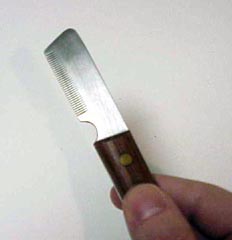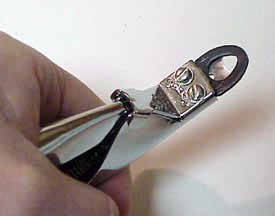Grooming Your Jack Russell Terrier
Very few animals are exhibited exactly as nature has designed them, and the Jack Russell Terrier is one that can certainly benefit from some judicious grooming before arriving at his next show.

Very few animals are exhibited exactly as nature has designed them, and the Jack Russell Terrier is one that can certainly benefit from some judicious grooming before arriving at his next show. The Jack Russell is one of the few remaining breeds still capable of earth work, and as such, his coat is very important to the job he is bred for.
A correct JR coat is hard, dense and lies close to the body. In preparing JR's for exhibition, we should keep in mind the breed standard specifies, smooth without being sparse, so as to protect from the elements and undergrowth. In order to bring a terrier coat into good condition, the coat should be plucked or stripped at least six to eight weeks prior to the show. Plucking involves using a stripping knife, a course knife for the body, medium knife for the neck and shoulders, and a fine blade for head and ears. (Most pet supply shops carry stripping knives.) For those who are unfamiliar with the stripping process, the knife is grasped in the right hand, taking a few hairs between the thumb and knife blade, and giving a sharp pull. Dogs that have never been stripped before will take a little getting used to the process, so it's best to do a little each day instead of covering the whole dog in a short time. The knife should be held parallel to the dog's body to avoid leaving chop marks in the coat.

Showing Considerations
Timing and preplanning need to be considered in preparing a terrier coat for showing. Give the dog an adequate time to regrow the coat before he is shown. Depending on how much coat has been plucked out, it could take nearly three months to re-establish a good thick coat. Keep in mind when plucking a rough coated dog that he should be exhibited as a rough coat, and not a broken coated dog. The same for a broken coated terrier ... he should not be stripped down and shown as a smooth coated dog. Coat type is important when choosing breeding stock, and conformation showing is for the purpose of showing breeding stock, so terriers should be exhibited in the coat that reflects the genes they have inherited.
Repeated strippings of a terrier's coat has its advantages. The main benefit is an improvement in coat texture and lie of the hair. It may take two or three complete strippings, but the new coat will come in harsher in texture than the original coat, and it will lay tighter to the body, giving a clean, smooth appearance.
Trimming Toe Nails
 Toe nails need to be trimmed back, being careful not to cut through the nail quick. By removing small amounts of nail, you will see a small white dot in the center of the nail. If you remove more nail, you'll see a red dot that is the beginning of the quick, which is the blood supply to the nail. Stop at this point. If you accidently cut the quick the bleeding can be stopped with nail clotting powder (available from your veterinarian), corn starch or some cotton applied with pressure to the end of the nail. After the toe nails have been trimmed, use a small sharp scissor to round off the hair of the feet and trim the long hairs between the undersides of the pads and feet. (Toe nail clippers can be purchased at any pet supply shop.)
Toe nails need to be trimmed back, being careful not to cut through the nail quick. By removing small amounts of nail, you will see a small white dot in the center of the nail. If you remove more nail, you'll see a red dot that is the beginning of the quick, which is the blood supply to the nail. Stop at this point. If you accidently cut the quick the bleeding can be stopped with nail clotting powder (available from your veterinarian), corn starch or some cotton applied with pressure to the end of the nail. After the toe nails have been trimmed, use a small sharp scissor to round off the hair of the feet and trim the long hairs between the undersides of the pads and feet. (Toe nail clippers can be purchased at any pet supply shop.)
Bathing
After the coat has been stripped, the terrier can be bathed if his skin and remaining coat are dirty. Never bathe the terrier before stripping, as soap and water soften the coat and will sometimes cause the hair to wave or curl. If you do bathe the terrier, do so far enough in advance of the show so as to allow the normal hardness of the coat to return. The coat will usually return to its normal texture in about 10 days. If you bathe the dog, it would be best not to use a hair dryer to dry his coat. Hair dryers leave most terriers looking fluffy, which is not what the judge is looking for. After bathing and towel drying, he should be rugged with a dry towel. This involves using a folded, medium-sized towel, placed over the dog's body and secured at the throat and tucked up with safety pins. The reason for rugging the dog is to get the coat to lie flat when dry.
Rough/Broken
Grooming a rough or broken coated terrier for home is a much easier process. After a thorough combing with a slicker brush to remove loose hair and dirt in the coat, an electric clipper can be used to keep the coat at a convenient length. The clipping process is easier on an aged terrier than is plucking or stripping. While on the subject of electric clippers - in the interest of correctness, electric clippers should not be used on a terrier that will be shown. Clippers do not promote good coat texture, and they cause the coat to lift or curl away from the dog's body. A dresser comb may be useful to thin or shorten the hair by running it over the coat in a long combing stroke. (Dresser comb and blades available at pet supply shop.)
Summary
In summary, when grooming your Jack Russell, remember that he should be presented as naturally as possible, in a manner that best exhibits his coat and structure as a working terrier. Grooming should be done well in advance of the show; powders, chalks, polish, grooming tables, scissors, clippers, etc. should not be present at a working terrier trial. The dog should arrive at his best, and the only last-minute touch up he should need might be a quick combing with a slicker brush.
Preparing a terrier in such a way to enhance its merits and minimize its faults is nothing short of an art if done correctly. It takes time and experience to become accomplished at this, but we can all take pride in presenting the judge with a clean, smart looking terrier at the next show.
GROOMING THE JACK RUSSELL TERRIER
by Mary Potter, PA
October 1988
Pet Groomer Web Site
Pet Grooming Kit